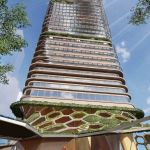
5 ways architecture is fighting climate change
The cities of the future will be almost entirely green
April 22nd, 2022
Hong Kong architecture firm Ronald Lu & Partners is one of the most important hubs dedicated to sustainability in urban planning and architecture - and because of this commitment, it has produced a paper that discusses the main innovations that already exist in the world today and could revolutionize the world of urban planning in the future. The idea behind these five ways to make architecture more sustainable is to take advantage of technical knowledge and material research to make buildings increasingly integrated with the surrounding natural environment, creating a man-made ecosystem in which humans and nature can be one.
Here are the 5 ways architecture is fighting climate change.
1. Biophilic Design

Biophilic design is a central concept in the philosophy of sustainable architecture and describes the link between buildings and the ecosystem that surrounds them through their relationship with the natural environment. This type of design is essential when it comes to high-density urban areas since this type of design promotes city cooling, rainwater reduction, and particulate air filtration. Ronald Lu & Partners has applied this concept in its Treehouse project - an eco-conscious integrated system that seamlessly connects interior to exterior, man to nature. It is a zero-impact workplace focused on worker well-being with walls covered in greenery, water features and nature-themed materials and furnishings.
2. The biodiversity issue
One of the main problems of modern megacities is the decline in biodiversity, which must be solved by repopulating urban areas with animals - a need made even more pressing by the pandemic. The solution here is simple: increase the amount of urban greenery by allowing animals to build their own habitat in harmony with the human population. One of the examples of this type of urban design is the Victoria Dockside in Hong Kong - an "active hill" covered with greenery at 30% of its extension and composed of several terraces that not only encourages the presence of animals in the urban area but also promotes ventilation and cooling of the surrounding streets.
3. The importance of carbon neutrality
Decarbonization is an issue that affects not only urbanism itself but our daily lives. The goal of achieving carbon neutrality by 2050 involves about 130 countries - but in the future it will increasingly depend on the ability of buildings and cities themselves to absorb this type of impact by solving the already urgent problem of pollution in the city. The solution to achieve neutrality in modern buildings is not unique but involves a series of innovations that, together, help improve the quality of the surrounding air. An example brought to you by Ronald Lu's firm is the Zero Carbon Park in Hong Kong - one of the world's most advanced buildings in terms of carbon neutrality.
4. The problem of the increasing temperatures
Global warming is already a reality in our world - designing with the impact of high temperatures on citizens' lives in mind is therefore a prerequisite for all urban planning. By 2050, the number of people affected by rising temperatures will increase by 800%, about 1.6 billion, and especially in high-density urban centers. The higher the temperature the greater the energy expenditure, but the damage that heat and humidity do to concrete and metal structures must also be taken into account. The two main solutions are natural ventilation and greening. The former cools buildings through ventilation corridors and air paths, including through the porosity of materials; as well as the presence of water. The greening of urban surfaces, on the other hand, plays a considerable role in cooling cities because it insulates roofs and walls, reducing energy loss. Trees and other urban vegetation, for example, create shade and cooling through evapotranspiration.
5. The management of water sources
Urban water management strategies are an increasingly critical issue in a world that is already headed for drought. The solution proposed by sustainable urbanism is to make these strategies similar to natural soil processes - this type of concept has been called Sponge City. Through this technique, surface runoff of rainwater is first absorbed, then naturally filtered by the soil. The infiltration of runoff allows aquifers to replenish themselves and water bodies to regenerate by eliminating malodorous water sources and restoring natural habitats.











































































